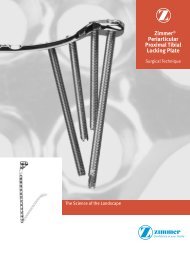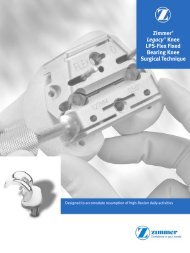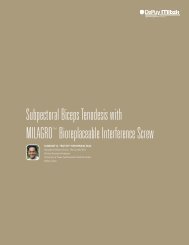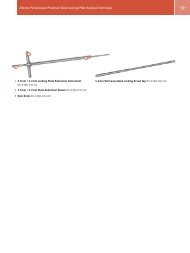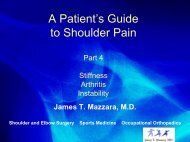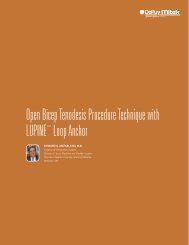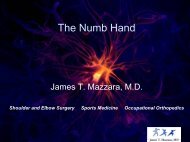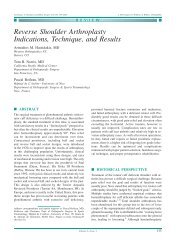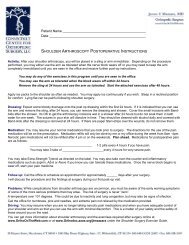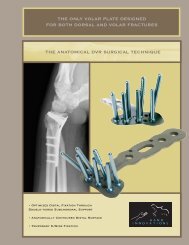Postoperative Distal Biceps Tendon Repair Rehabilitation Protocol ...
Postoperative Distal Biceps Tendon Repair Rehabilitation Protocol ...
Postoperative Distal Biceps Tendon Repair Rehabilitation Protocol ...
You also want an ePaper? Increase the reach of your titles
YUMPU automatically turns print PDFs into web optimized ePapers that Google loves.
<strong>Postoperative</strong> <strong>Distal</strong> <strong>Biceps</strong> <strong>Tendon</strong> <strong>Repair</strong> <strong>Rehabilitation</strong> <strong>Protocol</strong><br />
A CUTE R EPAIR<br />
PHASE I: 1-3 WEEKS<br />
• For the first post op week, the patient is in a posterior splint that is not to be removed. Beyond that point, the patient wears a<br />
removable posterior splint or a hinged elbow brace locked at 90 degrees.<br />
• This brace is removed or unlocked for the exercises as described here.<br />
Clinical Goals<br />
• Elbow ROM from 30 degrees of extension to 130 degrees of flexion<br />
• Maintain minimal swelling and soft tissue healing<br />
• Achieve full forearm supination and pronation<br />
Testing<br />
• Bilateral elbow and forearm ROM<br />
Exercises<br />
• Patient should perform passive ROM exercises from 30 degrees of extension to 130 degrees of flexion 5-6 times per day for 25<br />
repetitions.<br />
• Apply ice after exercise sessions.<br />
• A sling or “cuff and collar” may be used for the splint or hinged brace respectively. Shoulder ROM exercises are encouraged.<br />
PHASE II: 3-6 WEEKS<br />
Clinical Goals<br />
• Full elbow and forearm ROM by 6 weeks.<br />
• Scar management.<br />
Testing<br />
• Bilateral elbow and forearm ROM<br />
• Grip strengthening at 4-6 weeks
<strong>Distal</strong> <strong>Biceps</strong> <strong>Tendon</strong> <strong>Repair</strong> <strong>Rehabilitation</strong> <strong>Protocol</strong><br />
James T. Mazzara, MD<br />
PHASE II: 3-6 WEEKS<br />
Exercises<br />
• Week 3<br />
o<br />
o<br />
o<br />
o<br />
o<br />
• Week 4<br />
o<br />
o<br />
o<br />
o<br />
o<br />
• Week 5<br />
o<br />
o<br />
o<br />
o<br />
• Week 6<br />
o<br />
o<br />
o<br />
o<br />
o<br />
o<br />
o<br />
Active extension limit changed to 20 degrees. Passive flexion may be increases to full<br />
flexion as tolerated. Brace is worn at all times except when exercising or bathing.<br />
Scar massage 3-4 times per day.<br />
Active wrist flexion / extension.<br />
Active ROM of hand in neutral position.<br />
Supination / pronation through pain-free range.<br />
Active extension limit changed to 10 degrees.<br />
Continue same exercises.<br />
Putty may be used 3 times per day to improve grip strength.<br />
Ladder with arm supported by unaffected extremity.<br />
Gentle pulley while limiting elbow extension to -10 degrees.<br />
Full active extension is permitted.<br />
Brace is worn for full 6 weeks.<br />
Supine scapula stabilization with no weight.<br />
Alphabet door / clockwise / counterclockwise circles with ball.<br />
At the end of 6 weeks, the brace may be discontinued.<br />
Passive elbow extension exercises may be started if needed.<br />
Light strengthening exercises are started with light tubing or 1-kg weights for elbow flexion,<br />
extension, forearm rotation and wrist flexion and extension.<br />
Shoulder Theraband strengthening exercises are started.<br />
Supine scapula stabilization with 1kg weight.<br />
Ball toss / trampoline chest pass 1kg weight.<br />
Ice after strengthening exercises.<br />
CLINICAL FOLLOW-UP<br />
o<br />
Patients are usually seen at 1 week post op, then at 5-6 weeks post op. Final visits are usually<br />
at 12 weeks.
<strong>Distal</strong> <strong>Biceps</strong> <strong>Tendon</strong> <strong>Repair</strong> <strong>Rehabilitation</strong> <strong>Protocol</strong><br />
James T. Mazzara, MD<br />
PHASE III: 6 WEEKS TO 6 MONTHS<br />
Clinical Goals<br />
Testing<br />
• The strengthening program is gradually increased so that the patient is using full weights by 3 months.<br />
It may be as long as 6 months before a patient returns to heavy work.<br />
• Grip strengthening<br />
• Elbow ROM<br />
Exercises<br />
• Elbow ROM exercises if ROM is limited.<br />
• Strengthening exercises to wrist, forearm, and possibly shoulder, depending on sport and/or work<br />
requirements.<br />
Clinical Follow-up<br />
• The patient is seen as needed to monitor the progress with strengthening programs.<br />
A LLOGRAFT R ECONSTRUCTION<br />
• This program is delayed when allograft is used.<br />
• Patient is placed in a posterior splint with the elbow at 90 degrees of flexion and forearm in neutral<br />
rotation for ~ 7days.<br />
• At 7 days post op:<br />
o Splint is removed and replaced with a removable posterior splint or a hinged elbow brace<br />
locked at 90 degrees.<br />
o Passive forward flexion is allowed (90 – 150 degrees). Full flexion is permitted based on<br />
pain. Passive exercises are repeated 2 times per day, 25 repetitions.<br />
o Passive extension is allowed to 30 degrees from the first week after surgery.<br />
• Weeks 3-6<br />
o Passive assisted motion is begun.<br />
o Avoid full extension until after 6 weeks.<br />
• Weeks 6-12<br />
o Active motion for activities of daily living allowed.<br />
• 3-6 Months<br />
o Activity as tolerated progress



